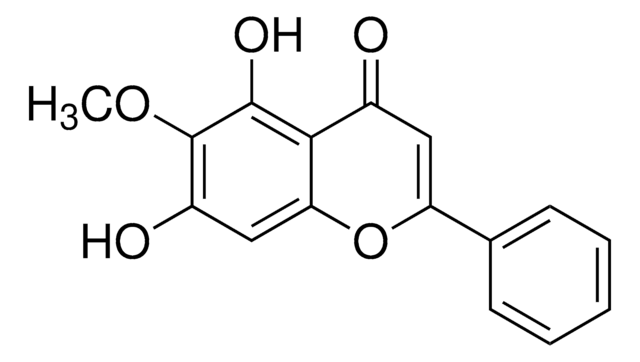A3539
3-Amino-2,3-dihydrobenzoic acid hydrochloride
≥98%
Synonym(s):
5-Amino-1,3-cyclohexadiene-1-carboxylic acid hydrochloride, Gabaculine hydrochloride
Sign Into View Organizational & Contract Pricing
All Photos(1)
About This Item
Empirical Formula (Hill Notation):
C7H9NO2 · HCl
CAS Number:
Molecular Weight:
175.61
Beilstein:
4552667
EC Number:
MDL number:
UNSPSC Code:
12352200
PubChem Substance ID:
Recommended Products
Assay
≥98%
mp
203 °C (dec.) (lit.)
storage temp.
2-8°C
SMILES string
Cl[H].NC1CC(=CC=C1)C(O)=O
InChI
1S/C7H9NO2.ClH/c8-6-3-1-2-5(4-6)7(9)10;/h1-3,6H,4,8H2,(H,9,10);1H
InChI key
OBZFLUDUSNCZKL-UHFFFAOYSA-N
Gene Information
human ... GABRG1(2565) , GABRG2(2566) , GABRG3(2567)
Looking for similar products? Visit Product Comparison Guide
General description
γ-aminobutyric acid (GABA) is an inhibitory neurotransmitter that binds selective transmembrane receptors, resulting in gating of ion channels in the central nervous system. GABA that is released from the receptors is degraded by GABA-transaminase. Gabaculine (3-Amino-2,3-dihydrobenzoic acid) is a neurotoxin that was first isolated from Streptomyces toyocaenis and is a conformationally constrained analog of GABA. Gabaculine inhibits GABA-transaminase, which results in an increase of endogenous GABA in the brain and spinal cord.
Biochem/physiol Actions
3-Amino-2,3-dihydrobenzoic acid hydrochloride potently and specifically inhibits GABA-transaminase (GABA-T), resulting in inhibited degradation of GABA. May inhibit glutamic acid decarboxylase (GAD), though it is 1000-fold more effective as a GABA-T inhibitor than as a GAD inhibitor.
Storage Class Code
13 - Non Combustible Solids
WGK
WGK 3
Flash Point(F)
Not applicable
Flash Point(C)
Not applicable
Personal Protective Equipment
dust mask type N95 (US), Eyeshields, Gloves
Choose from one of the most recent versions:
Already Own This Product?
Find documentation for the products that you have recently purchased in the Document Library.
Masahiro Irifune et al.
Canadian journal of anaesthesia = Journal canadien d'anesthesie, 54(12), 998-1005 (2007-12-07)
gamma-Aminobutyric acid (GABA) and N-methyl-D-aspartate (NMDA) receptors are important targets for anesthetic action at the in vitro cellular level. Gabaculine is a GABA-trans-aminase inhibitor that increases endogenous GABA in the brain, and enhances GABA activity. We have recently shown that
Viktor Demko et al.
Journal of plant physiology, 167(9), 693-700 (2010-02-05)
Synthesis of 5-aminolevulinic acid (ALA) represents a rate limiting step in the tetrapyrrole biosynthetic pathway, and is regulated by metabolic feedback control of glutamyl-tRNA reductase (GluTR) activity. The FLU protein has been attributed to this regulation. Later in the biosynthetic
P J Loida et al.
Archives of biochemistry and biophysics, 372(2), 230-237 (1999-12-22)
The metabolite 5-aminolevulinic acid (ALA) is an early committed intermediate in the biosynthetic pathway of heme and chlorophyll formation. In plants, 5-aminolevulinic acid is synthesized via a two-step pathway in which glutamyl-tRNA(Glu) is reduced by glutamyl-tRNA(Glu) reductase (GluTR) to glutamate
Tatsuru Masuda et al.
Plant physiology, 128(2), 603-614 (2002-02-14)
To elucidate the mechanism of an irradiance-dependent adjustment in the chlorophyll (Chl) antenna size of Dunaliella salina, we investigated the regulation of expression of the Chl a oxygenase (CAO) and light-harvesting complex b (Lhcb) genes as a function of Chl
C G Kim et al.
The Journal of biological chemistry, 273(11), 6030-6040 (1998-04-16)
The biosynthesis of ansamycin antibiotics, like rifamycin B, involves formation of 3-amino-5-hydroxybenzoic acid (AHBA) by a novel variant of the shikimate pathway. AHBA then serves as the starter unit for the assembly of a polyketide which eventually links back to
Our team of scientists has experience in all areas of research including Life Science, Material Science, Chemical Synthesis, Chromatography, Analytical and many others.
Contact Technical Service







